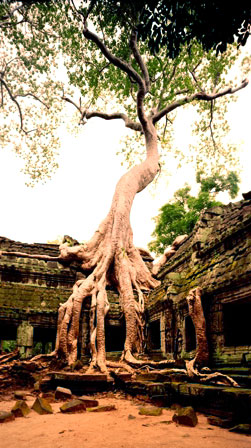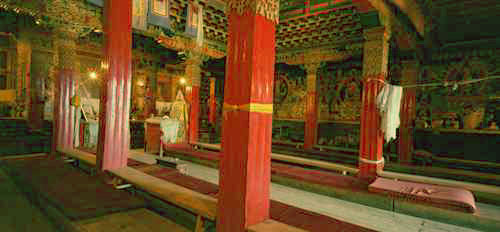A Review by Thomas J. A. Lehman

The Horseman SW612 PRO‚ An all-around camera.
Thinking of doing panoramics but find that the Fuji or Linhof 617 models are just too big? Want to go really wide angle but still have medium format negative size? Love to be able to keep buildings straight, but don‚t want to carry a view camera or have to get under a dark-cloth when photographing in public places? Tired of arguments over which of the 6×4.5, 6×6, 6×7, 6×9 or 6X12 formats are preferable?
Then the Horseman SW612 PRO may be just what you are looking for.
I love to travel and take photographs, and I assume most visitors to the Luminous Landscape share these passions. I‚m also a firm convert to medium format. Except for wild life photography and sporting events, my Nikon stays home. The image quality of a medium format print at 11×14″ or larger is incredible. Like many of you, I‚ve tried a variety of cameras. My Rollei 6008i is a workhorse which will cover a large variety of situations with automatic metering and a range of state-of-the-art features. However, it doesn‚t truly go super-wide. It does have a shift/tilt lens available, but only at a focal length of 55mm. At U.S. $7,000 + for this lens, I decided not to get one. Instead I bought the Horseman SW612 PRO.

Angkor Wat‚ panoramic cropped from 6X12 negative. Horseman SW612pro, 55 mm lens, Kodak Portra VC 160.
The Horseman has interchangeable lenses 35mm, 45 mm, 55, 65, 75 and 90 mm. The angles of view respectively are 120 o , 102, 91, 81, 73, and 64 when used with a 6×12 back. These are all Rodenstock Grandagons in a custom helical mount. I have the 55mm lens‚ it‚s tack sharp. Some reviewers have commented that this is a big camera, but it‚s smaller, lighter, and easier to handle than my Fuji 690 GWIII. With the 55mm I‚ve taken beautiful 6×12 panoramics. Many could easily be cropped to 4X12 for a 1:3 ratio, like those produced by the 617s, simply by eliminating excess sky (which is what the 617s force you to do). Further, with the majority of lenses you can use 15 mm of vertical shift to eliminate excess foreground without pointing the camera upwards. You can‚t do that with any of the 617s or with a Hasselblad XPan. If you want to photograph a very tall tree or building you can turn the camera on its side and combine 6×12 coverage with 15 mm of shift‚ it‚s awesome!!
Many of the photography related sites have constant messages about the best negative size. The Horseman is flexible because 6×7, 6×9, and 6×12 roll film backs are available. But, I don‚t think anything other than 6×12 makes sense for this camera. It‚s easy to crop your image if you don’t want that wide a format and there are all sorts of interesting possibilities for 11×14 prints within a 6×12 negative. I‚ve also printed 10×30, 20×30 and 16×20 selections from my negatives.

A Fichus growing out of the roof of a temple at Angkor Wat using the cameraturned vertically and the back shifted 15 mm downward. Horseman SW612 pro,55 mm lens, Kodak Portra VC 160.
While the camera is easy to use, it‚s completely manual. You must remember to cock the shutter on the lens and there is nothing to remind you to advance the film. There‚s no meter‚ bring your own. The supplied viewfinder doesn‚t focus. You can either guesstimate using the depth of field markings on the lens or put in the ground glass back and cover yourself with a dark cloth. It took only a single outing to realize that the depth of field of the lenses is so great that the ground glass is rarely necessary. Unfortunately you also either have to guess the effect of your shift, or use the ground glass again. However, this doesn‚t require the careful viewing that focusing does, so I find that I can do it without a dark cloth.
Therearesome cons to this camera. The shift and rise are not geared therefore intermediate positions can slip if the screws aren‚t tightened enough. You also have to handle the camera with some care. It‚s not as rugged as the Fuji 690 GWIII. As with all very wide angle medium or large format lenses, for very wide angle pictures a center filter is needed. I spent several hundred dollars for one, only to find it made little difference with the 55mm and I don‚t use it. Further, the lenses’ filter diameters jump back and forth between 58mm and 67 mm so you might need two. However the 35, 55, and 90mm all take 67 mm filters. At first I thought that I might need several lenses, but the 55 turned out to be wide enough for everything I‚ve wanted to do. Since I often crop, and the negative is a big 6×12, I couldn‚t see a reason to buy the 90 mm. I just try and get closer.

Interior of a Tibetan temple using 15 mm of upward front lens shift toincrease the amount of ceiling ornamentation visible without bending thepillars. Horseman SW612 pro, 55 mm lens, Kodak Portra VC 160.
This isn‚t the camera for every situation. However, it gives you a lot of flexibility if you need a moderate vertical shift, 6×12 negatives you can crop any way you want for panoramic work, and a very wide angle of coverage. All this comes at a lower price than the Rollei 55 mm pc lens, or a 617 like those from Fuji or Linhoff. The Horseman is comparable in cost to the Hasselblad XPan with a 30 mm lens, but gives you shift, an even larger field of view when used with its 35 mm lens, and a larger negative. A view camera with a 6×12 back would be more cost-effective and more flexible, but larger and much more trouble to travel with. The Horseman SW612 Pro fills a unique niche.
Thomas J. A. Lehman
I began photographing as a child with a black Brownie box camera. All exposure adjustments were made in the dark room with my father. I was probably influenced toward medium format by his careful use of a Speedgraphic. In high school and college I became a firm convert to 35 mm starting with a Minolta SRT 101 and slowly working my way up. Over the last 7 years I‚ve had increasing opportunities for …work related travel.‚ I became discontent with the results of pointing an auto-exposure, auto-focus Nikon at interesting things and pushing the button. Switching to medium format has given me much more enjoyment in both the process of making pictures and in the final result. In now utilize a Rollei 6008i, a Fuji 645zi (for use in crowds and marketplaces where I need auto-focus and auto-exposure), and the Horseman 6X12 Pro, reviewed here.
All text and photographs on this page are Copyright ‚© 2000 by Thomas J. A. Lehman
You May Also Enjoy...
Convergence – Palouse
Please use your browser'sBACKbutton to return to the page that brought you here.
